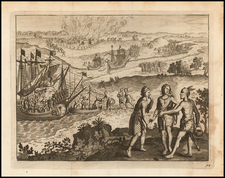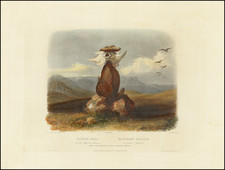In Mato-Tope. A Mandan Chief., Karl Bodmer captures a vivid depiction of a revered Mandan warrior and chief, Mato-Tope or "Four Bears", epitomizing the intricate cultural tapestry of the Missouri frontier in the 1830s. Bodmer's meticulous detailing and his remarkable ability to invoke the essence of his subject have lent this piece an enduring artistic and historical significance.
In the context of the prevailing geopolitical dynamics on the Plains, the emergence of Mato-Tope, a military strategist and renowned warrior, marked a critical chapter in the resistance and resilience of the indigenous populations against encroaching colonial forces. He was esteemed not just for his formidable bravery, but for his profound intelligence, generosity, and deep understanding of Mandan and neighboring tribal customs. This piece, the original artwork for which was painted at Fort Clark in 1834, offers an invaluable ethnographic record of a notable figure within indigenous history, immortalizing Mato-Tope in his formal attire indicative of his esteemed rank.
Bodmer’s execution of detail lends a unique dimension to this aquatint, encapsulating an array of symbolic elements within the indigenous warrior’s attire. The elaborate trim of ermine tails, locks of hair, and intricate quillwork, coupled with the painted symbols and war wounds, weave an elaborate narrative of Mato-Tope’s military exploits. The extensive headdress adorned with eagle feathers presumably represents the combined battle coups of an entire war party or men's warrior society, further embellishing the aura of this distinguished Mandan leader.
Furthermore, Bodmer has cleverly depicted Mato-Tope holding a lance, potentially the same weapon earlier described by George Catlin as the instrument used by Mato-Tope to avenge his brother's murder, subsequently adorned with the enemy’s scalp stretched on a hoop. These fascinating details, immortalized in Bodmer's aquatint, convey the depths of Mato-Tope's bravery and his artistic inclination, reflecting his tradition of illustrating his military deeds on his body, clothing, and buffalo robes. Mato-Tope. A Mandan Chief. is not only an important engraving but a historical document that enriches our understanding of the complexities of the indigenous societies during this transformative period in North American history.
State
Ruud's 1st of 2 states, lacking the date.









![(Arizona Frontier Wars) [Archive of Original Manuscript Documents and Photographs: Holograph Draft Notes and Typescript of Sladen's Making Peace with Cochise, Chief of Chiricahua Indians 1872; Tintype of J. A. Sladen; Cabinet Card photograph of Tom Jeffords, Indian Agent and U.S. Army Scout; another Photo of Concepción, Mexican-Apache Translator]](https://storage.googleapis.com/raremaps/img/small/99886.jpg)
![(North Dakota) Scalp Dance of the Minatarres [near Fort Clark, on the Missouri River]](https://storage.googleapis.com/raremaps/img/small/77692.jpg)


![[Original photograph] Native Americans, possibly Creeks, in outdoor camp with white settlers or Indian Agents.](https://storage.googleapis.com/raremaps/img/small/78740.jpg)
